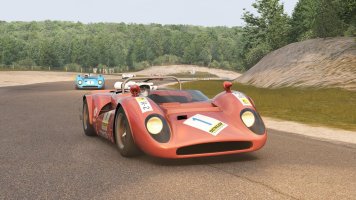Once again, Historic Sim Studios throw it back to the 1960s: Their Toyota 415S Flatnose pays tribute to the racing roots of the Japanese manufacturer.
Toyota and motorsport and inseparably linked. One of the top teams in WEC currently, the Japanese manufacturer has wowed fans with its LMP1 machines, the Toyota GT-One of the late 1990s, and a number of Group C and IMSA GTP cars. The marque was not always at home on the racing circuits of the world, however.
Back in 1967, Toyota decided to go racing and started development of the first of three models as part of the Toyota 7 project. Dubbed 415S, the car was designed to Group 7 regulations and powered by a 3-liter V8 engine. The car was completed in early 1968 and made its debut at the 1968 Japanese Grand Prix at Fuji Speedway.
Footage from the 1968 Japanese Grand Prix, mostly focusing on the Nissan R381s.
Overall victory was not within Toyota's grasp, but Otsubo and Fushida finished in positions 8 and 9, respectively, meaning they scored a 1-2 in their own class. Fukuzawa was classified in 14th despite a failing drive shaft, but Hosoya had to retire about halfway through the race due to losing oil pressure. Still, a successful foundation for the project was laid at Fuji.

When Toyota's main competitor Nissen dropped out of competition, however, Toyota followed shortly after. Plans to enter the 578A in Can-Am were shelved. The deaths of factory drivers Fukuzawa (in early 1969) and Minoru Kawai (in 1970), who both lost their lives in testing accidents, likely also played their part in the decision.
Another car of Historic Sim Studios, the Daihatsu P-5, also competed in the 1968 Japanese Grand Prix, winning the GP-I category after being the only model in the class that actually qualified for the race. It had made its debut in the 1967 season, and Toyota actually bought Daihatsu in 1969.

The Toyota 415S is another great testament to one of sim racing's best qualities (in the author's opinion, anyway): going back in time with car-track combos that are no longer around. All 415S that have been built were destroyed after the car was retired, and Fuji is looking far different today compared to its original, steeply-banked version. And the fact that lesser-known cars and tracks are part of this is fantastic.
What are your impressions of the Toyota 415S Flatnose by Historic Sim Studios? Let us know on Twitter @OverTake_gg or in the comments below!
Toyota and motorsport and inseparably linked. One of the top teams in WEC currently, the Japanese manufacturer has wowed fans with its LMP1 machines, the Toyota GT-One of the late 1990s, and a number of Group C and IMSA GTP cars. The marque was not always at home on the racing circuits of the world, however.
Back in 1967, Toyota decided to go racing and started development of the first of three models as part of the Toyota 7 project. Dubbed 415S, the car was designed to Group 7 regulations and powered by a 3-liter V8 engine. The car was completed in early 1968 and made its debut at the 1968 Japanese Grand Prix at Fuji Speedway.
Four Cars And A Class Win
Toyota entered four cars with Shihomi Hosoya, Sachio Fukuzawa, Hiroshi Fushida, and Yoshio Otsubo behind their wheels. Fukuzawa would achieve the best starting position in sixth, albeit almost six seconds behind the pole-setting Nissan R381 of Kunimitsu Takahashi. The remaining 415S entries lined up in ninth (Fushida), 10th (Hosoya) and 12th (Otsubo). Of course, it is worth noting that Toyota competed in the GP-III class, while the R318s were running in the GP-IV class.Overall victory was not within Toyota's grasp, but Otsubo and Fushida finished in positions 8 and 9, respectively, meaning they scored a 1-2 in their own class. Fukuzawa was classified in 14th despite a failing drive shaft, but Hosoya had to retire about halfway through the race due to losing oil pressure. Still, a successful foundation for the project was laid at Fuji.
The 7 Project Turns Deadly
The car continued to run well throughout 1968, scoring wins at the 1000km events at Fuji and Suzuka, among other good finishes. However, as development never stops in racing, the 415S was replaced by the 474S for 1969, now with a 5-liter V8. In 1970, the 578A took the spotlight, including a twin-turbo engine.When Toyota's main competitor Nissen dropped out of competition, however, Toyota followed shortly after. Plans to enter the 578A in Can-Am were shelved. The deaths of factory drivers Fukuzawa (in early 1969) and Minoru Kawai (in 1970), who both lost their lives in testing accidents, likely also played their part in the decision.
Toyota 415S Flatnose For Assetto Corsa
Now, Toyota's OG racing car makes its debut here on OverTake for Assetto Corsa. @Historic Sim Studios LLC revived the sportscar in its original 1968 guise, nicknamed 'flatnose', allowing sim racers to take a piece of Japanese racing history to the virtual tracks. The car should feel right at home at the 1968 rendition of Fuji uploaded by @WilliamTRiker, for instance.Another car of Historic Sim Studios, the Daihatsu P-5, also competed in the 1968 Japanese Grand Prix, winning the GP-I category after being the only model in the class that actually qualified for the race. It had made its debut in the 1967 season, and Toyota actually bought Daihatsu in 1969.
The Toyota 415S is another great testament to one of sim racing's best qualities (in the author's opinion, anyway): going back in time with car-track combos that are no longer around. All 415S that have been built were destroyed after the car was retired, and Fuji is looking far different today compared to its original, steeply-banked version. And the fact that lesser-known cars and tracks are part of this is fantastic.
What are your impressions of the Toyota 415S Flatnose by Historic Sim Studios? Let us know on Twitter @OverTake_gg or in the comments below!

